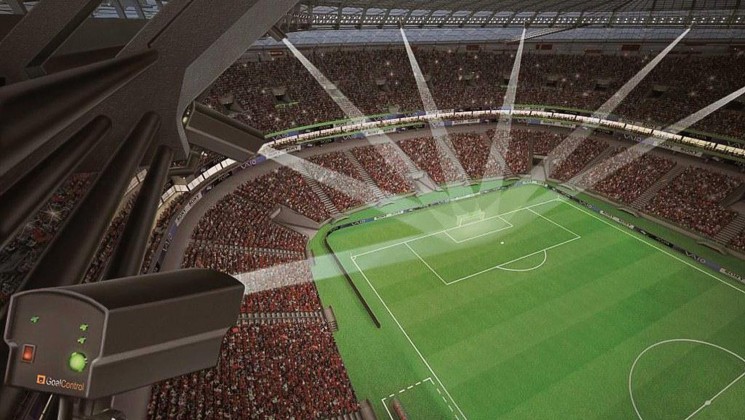
It’s not just Gaelic Games that rely on help from Hawkeye!
Hawkeye in Football
- Hawkeye in Football is based on the principle of ‘triangulation’ – using visual images and timing data provided by high-speed video cameras at different locations around the stadium.
- The cameras track the ball while it moves, while software calculates the ball’s location by following the pixels on the screen – even if some cameras can’t see it.
- The system records the ball’s path and stores it in a database which is used to create a picture of the flight path, which can then be shown on TV to show its path and position at any time
- The data from the system can also be used to create statistics for players and analyse trends.
- The system is almost real-time and a message is sent to a referee’s watch less than one second after the ball crosses the line.
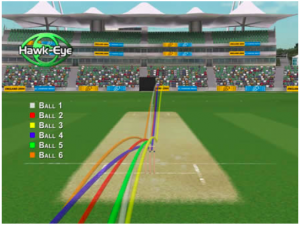 Hawkeye in Cricket
Hawkeye in Cricket
- The technology was first used in Cricket by Channel 4 during a match between England and Pakistan at Lord’s in May 2001.
- It is now used by most television networks to track the direction of balls in flight.
- Its major use in cricket is in testing leg-before-wicket (LBW) decisions, where Hawk-Eye can predict the likely path of the ball and say whether it would have hit the stumps if the batsman’s leg had not blocked it.
- The Hawk-eye decision for LBW is based on three criteria:
- Where the ball ‘pitched’ (bounced)
- The location of impact with the leg of the batsman
- The projected path of the ball past the batsman
- Information such as the exact spot where the ball pitches, or the speed of the ball from the bowler’s hand (to gauge batsman reaction time), can also help in post-match analysis.
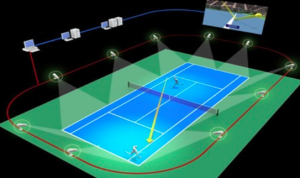 Hawkeye in Tennis
Hawkeye in Tennis
- In late 2005 Hawk-Eye was tested by the International Tennis Federation (ITF) in New York and approved for professional use.
- Hawk-Eye has been used in TV coverage of several major tournaments including Wimbledon, the Australian Open, the Davis Cup and the Tennis Masters Cup.
- The 2007 Australian Open was the first Grand Slam tournament to allow players to challenge a decision by using Hawk-Eye.
- The Hawk-Eye technology was used in the 2007 Dubai Tennis Championships with some minor controversies.
- The ‘Hawk-Eye Innovations’ website says the system performs with an average error of 3.6 mm. The standard diameter of a tennis ball is 67 mm, meaning there is a 5% margin of error – which is roughly the same as the amount of fluff on the ball.
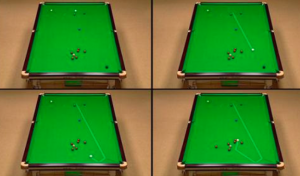 Hawkeye in Snooker
Hawkeye in Snooker
- At the World Snooker Championship 2007, the BBC used Hawk-Eye for the first time in its television coverage to show the player’s view of the table – especially where they were snookered.
- It has also been used to demonstrate what a player has intended to do, especially when they have not been able to pull it off.
- It is now used by the BBC at every World Championship, as well as some other major tournaments.
- In contrast to tennis, the Hawk-Eye is never used in snooker to assist referees’ decisions – and is only used to help TV viewers.
Hawkeye in Aussie Rules
- On July 4, 2013, the Australian Football League announced that they would be testing Hawk-Eye technology to be used in the ‘score review’ process.
- Hawk-Eye was used for all matches played at the Melbourne Cricket Ground during Round 15 of the 2013 AFL Season.
- The AFL also announced that Hawk Eye was only being tested, and would not be used to make any refereeing decisions during those games.
Hawkeye in Hurling and Gaelic Football
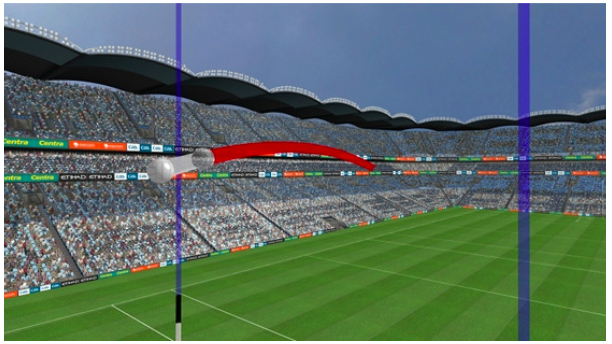
- In Ireland, Hawk-Eye was introduced for all Championship matches at Croke Park in Dublin in 2013. This followed consideration by
the Gaelic Athletic Association (GAA) for its use in Gaelic
football and hurling. - A trial took place in Croke Park on 2 April 2011. The double-header featured football between Dublin and Down and hurling between Dublin and Kilkenny.
- The GAA’s use of Hawk-Eye was intended to eliminate contentious scores. It was first used in the Championship on Saturday 1 June 2013 for a football match between Kildare and Offaly game.
- Hawkeye provides a real-time image on the stadium’s big screen, showing the path of the ball to say whether it went between the posts or not.
In 2013, the use of Hawk-Eye was suspended during the 2013 All- Ireland hurling semi-finals on 18 August because of a human error. During an under-18 game between Limerick and Galway, Limerick scored a point which Hawk-Eye said was ‘wide’ – even though the Hawk-Eye screen showed the ball going between the posts. The referee decided that the shot was wide, which caused anger among fans, viewers and TV analysts. Because of the mistake, it was decided not to use Hawk-Eye for the rest of the day.
Limerick lost the game by one point, and appealed the decision, but lost their appeal. Hawk-Eye apologised for this incident and admitted that it was a result of human error. It said the system had been accidentally set up for Gaelic Football instead of Hurling. The mistake took place on the same weekend that Hawk-Eye had been used for the first time in the Premier League in England, and the incident made the news in the UK,
What DOES Hawk-Eye do?
- It covers both Gaelic Football and Hurling
- It detects points only.
What does Hawk-Eye NOT do?
- It does NOT detect goals
- It does NOT cover other rules, like the ‘square ball’ rule
- It does NOT involve a TMO (Television Match Official)
How does it work?
- Eight high-speed cameras are installed, with four at each end
- They can follow the ball to a height of 26 metres – which is twice as high as the goalposts at either end of the pitch – and within 4 metres of each post
- The system pretends that the goalposts are high enough to touch the sky. If the ball would have hit the post, the shot is declared a ‘miss’ (i.e. wide).
- Both the ball and posts are tracked in real-time.
- Automated decision made within 1 second.
What happens on the pitch?
- The umpire makes a ‘box’ shape with his hands to tell the referee he wants to use Hawk-Eye to find out whether the ball went between the posts.
- The referee makes the same signal if he agrees with the request.
- The Hawk-Eye replay is shown on the big screen, and shows a graphic to announce whether the ball went between the posts.
- The referee confirms the decision and tells the umpire whether to award a point (by waving a white flag), a wide (by waving his hands) or a 45 (football) or 65 (hurling) by pointing to the line. The umpire does so and signals the decision.
Communicating The Decision
- Hawk-Eye generates a Virtual Reality (VR) video replay of the shot
- The replay is shown on the Big Screen
- The replay is also shown on TV
What happens if Umpire does not make a decision?
- If the ball has gone between the posts and over the bar, but the umpire does not make a signal, a ‘Review Official’ uses a radio to tell the referee that a Hawk-Eye review is necessary.
- The referee stops play and makes a ‘box’ signal with his hands to seek a Hawk-Eye review.
- The Hawk-Eye replay is shown on the Big Screen
- The referee will confirm the Hawk-Eye decision and awards a ‘point’, which is then signalled by the umpire.
What happens if Referee seeks Hawk-Eye review of an Umpire decision?
- If an umpire has made the wrong decision regarding a ‘point’ or ‘wide’, the Review Official communicates to the referee that Hawk-Eye should be used.
- The referee makes a ‘box’ signal with his hands to seek a Hawk-Eye review.
- The Hawk-Eye replay is shown on the Big Screen
- Referee confirms the Hawk-Eye decision and makes the appropriate decision.
- The Umpire signals that decision.
What happens if the system breaks down?
- If the big screen is not working, all decisions are announced to the crowd through the PA system.
- If the game is being shown on TV, the Hawk-Eye replay will be shown to TV viewers.
- If for any reason the Hawk-Eye system cannot make a decision about a point or wide, the final decision is made by the referee and his officials.
- A graphic confirming the referee’s decision is shown on the Big Screen.
